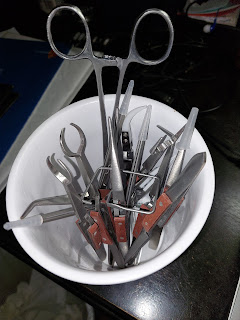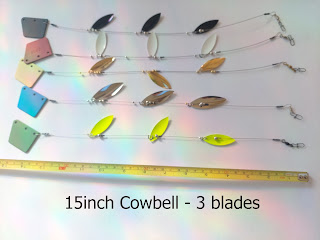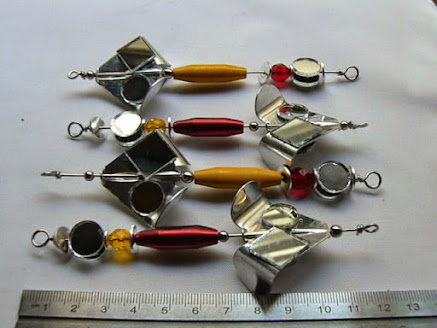I've got a new hobby! The necessity was to use up surplus tackle, and free up some storage and have some fun.
 |
| Carp on a Washer |
Swapped the wire former for a soldering iron. Turns out, once again, that storage suffers. Space is a problem as there is more gear than I imagined.
After a few prototypes, I found it fun. Doing preparations as much as the soldering. Mindless Repetition is one of my 'most favorite' pastimes!
Naturally, I'm collecting more soldering iron tools and 'investing'.
Tweezers are a useful commodity when doing soldering. They keep the pieces steady and your fingers from getting very hot and charred! Another post for these tools will be in order. I've went from not being able to find a tweezers to poke around on a sliver or pull off a tick, to needing to make a rack for them.
For now a flower pot works.
Temperature control is very important, solder comes is a variety of mixes.
My old solder gun was for sweating copper pluming pipe and handy, but not for this experience. I needed to get a far better variable speed soldering iron that lets me set temperatures for different types of solder. Did I mention flux? That too.
I found one that goes up to 500 Celsius - 932 Fahrenheit. Smoking hot! First thing I learned, after struggling to get the solder to stick, and big gobs of it where they didn't belong, was to 'tin' the solder iron point. (Very Important!!!) This simple process makes a better looking job and stronger bond between parts. Look back at the carp picture to see how badly I attached it to the washer. I'll get better! Do overs are pretty easy.
Alas, even those high temperature are not the end all or final choice.
Did you know there are 'hard' solders? You need a torch for those and 'silver solder'. Expensive stuff. I bought a handy butane torch, and it will chase solder all over your parts, but due to cost of silver solder, it was more skill and cost than I needed. So for now I stay out of that space, it's for Jewelers, and brazing brass and bronze and getting close to welding (Note - another future hobby out on the horizon).
The butane torch is now the go to fireplace torch, no more bic lighters!
Moving along, I needed some silicon workspace mats. Marie didn't want me to be burning holes in the table tops (neither did I).
Also a heavy duty wire cutter. I make the legs and antennae doodads from stainless steel 4/0 hooks, which are very hard and sharp. I found a steel wire/cable cutter pliers works great and it's a big prep timesaver. Snaps right through hard wire, but parts fly, so use them inside a bucket to keep the parts off the floor and keep the dog from getting a hook barb, in one of his paws.
Coming full circle, other then some new tools and materials,,, most of the components used are surplus tackle collected doing swaps with Tackle shops for space on their racks, walls, and counters in the Fish Creek Spinners wholesale market.
Countless types of spinner blades, metal beads, hooks, and wire in boxes, patiently waiting on my re-discovery. Turned out that surplus spinner bait forms were handy sources of steel wire and heavy duty hooks. Even a larger hook could be cut into useful building parts.
Here's a few pictures. Willow blades and spinnerbait chop jobs on hooks and wire.
 |
| Big Indiana blade body, Gold Willow Wings and an Inline blade head, antennae and legs from hook parts |
 |
| Tweezer Cooties - kind of bug creatures |
 |
| Big Nickel Indiana body, Hammered nickel wings, bead antennas |
 |
| Hammered Brass Willow body, #3/0 Treble hook tail, Worm collar neck and head |
 |
| Hammered Willow wings, Nickel bullet antenna |
Lots of creative ways to solder them together and plenty of variations of spinner blades. I'll make some Christmas Tree ornaments after I get tired of cooties. Yard Ornaments - always need some of those (the welding hobby)! For now, I'm going to provide them as swag on larger orders of spinners (customer appreciation) and perhaps sell them at Flea Markets. Still perfecting my solder skills! Life is short.
Stay tuned!
Need any? LOL.





























